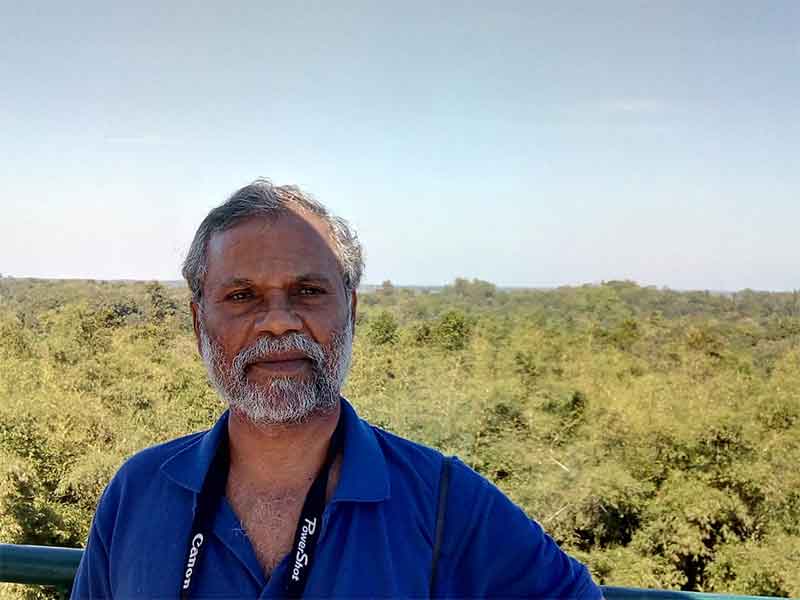
There was a new zeal and enthusiasm, and a strong sense of comradeship among the people of Markhera village as they assembled to plan the forests they were going to create near their temple. The temple site was chosen as the forest and the birds likely to find shelter in this were considered to be safer here. These villagers had just been involved in a very successful water conservation effort close to the temple and this would help in creating the new forest, just as the forest will also contribute to more water conservation in a protective cycle.
No, they were not going to create a plantation of exotic trees as seen in several official efforts. They were firm that a wide diversity of indigenous species will be planted, including those native species which have become rare or endangered in recent years. SRIJAN, a voluntary organization that had been working here earlier on water conservation, helped in coordination so that the plants of as many as 36 indigenous species could be obtained from the forest department’s nurseries at the right time. These species included mahua, karanj, peepal, bargad, kadamb, chandan, arjun, neem, anvla, sagvan, bel, jamun, chiraunji and wild varieties of some fruits.
The tree planting work was also planned in a very elaborate way which required more hard work to start with but was likely to give very good results later. Land was dug for about one meter, then layers of cow dung ( as many as 50 trolleys, villagers said), crop residues, fallen leaves were placed, before finally putting back the dug soil. It is only after enriching the soil organically in this way, while completely avoiding chemical fertilizers, that the planting work was taken up. Saplings were planted rather close to each other, with a vision of placing close those plants that can be supportive towards the growth of each other.
No less caring was the attitude of villagers in taking care of the plants. As Dhaniram Yadav says, “we used to come for watering these plants just as we take care of our own crops.” Amaan Raikwar adds, “ Whether it was bitterly cold weather or any other adversity, we did not let that come in the way of taking care of these plants.”
It is to the great credit of this village community that such voluntary contribution has been made on a steady basis. The result of all this commitment and hard work is there for all to see. The growth in just about 9 months has surprised and delighted villagers (the various plants had grown to the height of about 6 to 14 feet at the time of my visit in early January) and even people from other villages have been coming to see and admire the healthy growth of plants. A lot of credit is being given to the entirely organic enrichment of soil prior to planting and the good care provided at the time of early growth of trees. To the great surprise of villagers themselves, all plants have survived so far, a big achievement compared to the poor survival rate of several official efforts. About 1800 trees were planted here, and the cost per tree has also been kept exceptionally low for which the voluntary work of villagers should get a lot of credit.
Rani Yadav says—we are very happy to see these trees growing so well. When peacocks and parrots come here, it becomes such a beautiful sight. It is so good to have such a forest just near our temple.
Such forests have been created in several villages with the close involvement of communities and the entire initiative taken forward by SRIJAN initially in Tikamgarh district ( Madhya Pradesh) has been named Tapovan. In Daur village the trees planted by such an effort have maintained healthy and dense growth during the last two years. Rakesh Singh, team leader of this voluntary organization says that by this age or very soon after this forest has become more or less self-sustaining. As we walked inside the newly created forest, the growth was quite dense and those familiar with the initial planning stated that the growth so far has been according to their expectations. This is attracting many birds too. An elderly philanthropist Ramesh Kacholiya had contributed the entire budget for this particular forest in Daur from his savings and certainly these have been well spent to bring a lot of greenery.
Several such Tapovan forests have been created in Tikamgarh district and neighboring areas and now the concept is being taken forward in other areas as well. The Daur village forest, for instance, is a typical Tapovan based one planting about 1200 saplings in a 500 square meter area, although this area and density can be somewhat less or more from one place to another. This concept of Tapovan is based on the work and ideas of a Japanese botanist Akira Miyawaki that helps build dense native forests in relatively short time. This was adapted to local conditions in community discussions and generally a mix of canopy trees, other trees, sub trees and shrubs has been planted, (all native trees, also including trees of medicinal value, trees which are good for fodder etc). Special care has been taken to include species like banyan and peepal, often ignored in official efforts but very good for environment, health and biodiversity.
While there are very high hopes from this experiment, there are some questions also regarding the close spacing, particularly in the context of some species which need more space. Besides, one has to look at not just the upper growth of the plant but also at the root growth so important for essential longer-term growth of trees. Root growth of various densely planted species may need more study.
No one can know all the answers from the outset, even though a very intensive study of the Miyawaki model was made before the planting, and any flaws which come to light ( as per local conditions) later can be corrected as the work progresses and spreads to other areas.
An alternative approach which this writer has suggested in the past is to closely study the few surviving good natural forests of local area and then try to mimic them as closely as possible.
Bharat Dogra is Honorary Convener, Campaign to Save Earth Now. His recent books include Planet in Peril, Protecting Earth for Children and A Day in 2071.














































